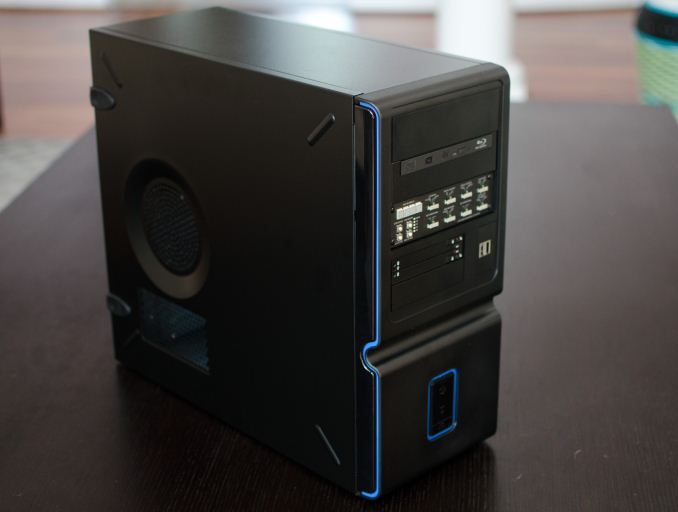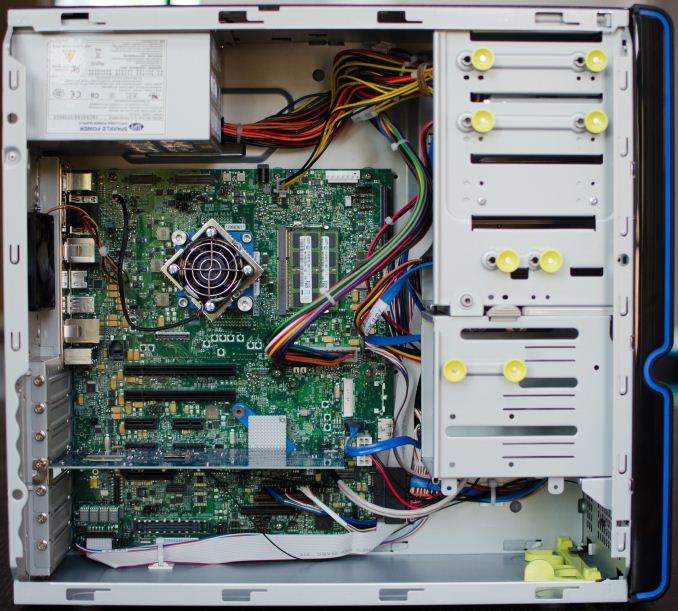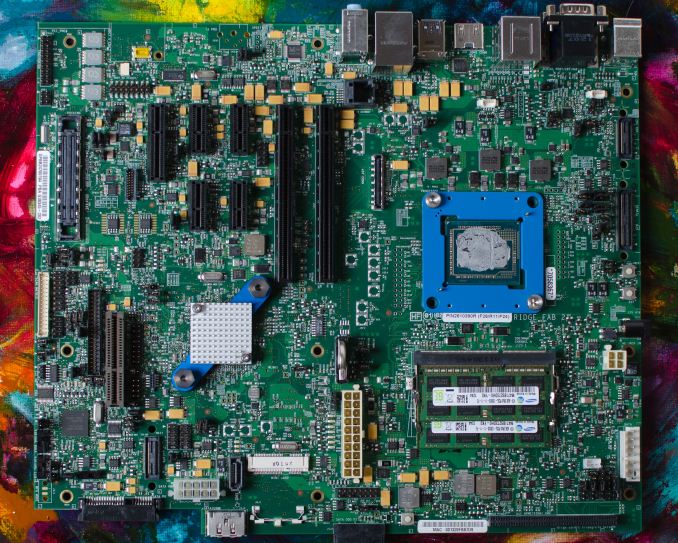Intel Iris Pro 5200 Graphics Review: Core i7-4950HQ Tested
by Anand Lal Shimpi on June 1, 2013 10:01 AM ESTThe Core i7-4950HQ Mobile CRB
At a high level, Iris Pro 5200 would seem to solve both problems that plagued Intel graphics in the past: a lack of GPU hardware and a lack of memory bandwidth. As a mostly mobile-focused design, and one whose launch partner isn’t keen on giving out early samples, it seemed almost impossible to evaluate Iris Pro in time for the Haswell launch. That was until a week ago when this showed up:
What may look like a funny mid-tower from a few years ago is actually home to one of Intel’s mobile Customer Reference Boards (CRB). Although the chassis is desktop-sized, everything inside is optimized for mobile. It’s just easier to build things larger, especially when it comes to testing and diagnosing problems.
The silicon on-board is a 47W Core i7-4950HQ, the lowest end launch SKU with Iris Pro 5200 graphics. The chassis is obviously overkill for a 47W part, but the performance we get with this machine should be representative of any i7-4950HQ system with a cooler capable of dissipating 47W.
If you read our Haswell CPU review you’ll know that Intel tried to be stingy with telling us die sizes and transistor counts for the bulk of the Haswell lineup, electing to only give us data on dual-core Haswell GT3 and quad-core Haswell GT2. Knowing that mobile parts ship without integrated heat spreaders, I went to work on pulling off the i7-4950HQ’s heatsink (after I finished testing, just in case).
With the heatsink off and thermal paste wiped off, I used my bargain basement calipers to get a rough idea of die area. This is what I came up with:
| Intel Haswell | |||||||||||||||||
| CPU Configuration | GPU Configuration | Die Size | Transistor Count | ||||||||||||||
| Haswell GT3e (QC) | Quad-Core | GT3e | 264mm2 + 84mm2 | ? | |||||||||||||
| Haswell GT2 (QC) | Quad-Core | GT2 | 177mm2 | 1.4B | |||||||||||||
| Haswell ULT GT3 | Dual-Core | GT3 | 181mm2 | 1.3B | |||||||||||||
The Crystalwell die measures 7mm x 12mm (84mm^2), while the quad-core Haswell + GT3 die is a whopping 264mm^2 (16.2mm x 16.3mm). Working backwards from the official data Intel provided (177mm^2 for quad-core GT2), I came up with an 87mm^2 adder for the extra hardware in Haswell GT3 vs. GT2. Doubling that 87mm^2 we get a rough idea of how big the full 40 EU Haswell GPU might be: 174mm^2. If my math is right, this means that in a quad-core Haswell GT3 die, around 65% of the die area is GPU. This is contrary to the ~33% in a quad-core Haswell GT2. I suspect a dual-core + GT3 design is at least half GPU.














177 Comments
View All Comments
virgult - Saturday, August 31, 2013 - link
Nvidia Kepler plays Crysis 3 well but it sucks insanely hard at computing and rendering.Eric S - Wednesday, July 3, 2013 - link
It appears to do compute better then graphics (and ECC memory is a plus for compute). That is exactly what pros will be looking for. Apple doesn't cater to the gaming market with these machines even if they should play most games fine. A dedicated gaming machine would be built much different then this.jasonelmore - Sunday, June 2, 2013 - link
This, I dont know about anyone else, but i'm not dropping 2 grand or $2700 with upgrades on a 15 incher that does not have dedicated graphics.Another problem i see is the 13" Retina only uses duals, and if they did use this quad with GT3e silicon, then the price of of the 13" will go up at least $150 since the i7's and i5's the 13" currently use, are sub $300 parts.
The only solution i see is Apple offering it as a build to order/max upgrade option, and even then they risk segmentation across the product line.
fteoath64 - Monday, June 3, 2013 - link
"can't sell a $2000 laptop without a dedicated GFX". Absolutely true, especially when the GT3e is still a little slower than the 650M. So the 750M tweaked a few mhz higher will do nicely for the rMBP. The 13 incher will get a boost with the GT3e CPU. So a slight upgrade to lower power cpu maybe worthwhile to some. Improvement to 1080p eyesight camera would be a given for the new rMBP.Eric S - Wednesday, July 3, 2013 - link
You can drop discrete graphics when that $2000+ laptop is using builtin graphics with the same price premium and number of transistors of the discrete chip. I'm almost positive the discrete will go away. I have a feeling that Apple had a say in optimizations and stressed OpenCL performance. That is probably what they will highlight when they announce a new MacBook Pro.xtc-604 - Saturday, June 8, 2013 - link
I really hope that Apple continues to treat the rMBP 15 as a flagship. Giving it iGPU only would be a deal breaker for many professionals. Atleast in haswell's current form. Until Intel can make an IGPU that atleast matches or exceeds performance at high resolutions, it is still a no go for me.Eric S - Wednesday, July 3, 2013 - link
Why is that a deal breaker? The Iris 5200 is better then a discrete chip for compute (OpenCL). If you are doing 3D rendering, video editing, photoshop, bioinformatics, etc. that is what you should care about. It also has ECC memory unlike a discrete chip so you know your output is correct. How fast it can texture triangles is less important. It still has plenty of power in that area for any pro app. This is not designed to be a gaming machine. Not sure why anyone would be surprised it may not be optimized for that.Eric S - Monday, July 1, 2013 - link
You never know, but I doubt it. They will have trouble with the ports on the side if they make it smaller. I think it is more likely the space saving will go to additional battery. They may be able to get similar battery life increases to the Air with the extra space.mikeztm - Tuesday, June 4, 2013 - link
Notice that the 13" 2012 rMBP is a little thicker than the 15" version. Quad core in 13 inch may be planned at the very beginning.axien86 - Saturday, June 1, 2013 - link
Look at the overheating issues that come with i5/i7 Razer notebooks and finding the same heating noticed in their Haswell notebook press event several days ago.
If Apple decides to use these Haswells which put out heat in a concentrated area and in very thin outlines, you are essentially computing over a mini-bake oven.